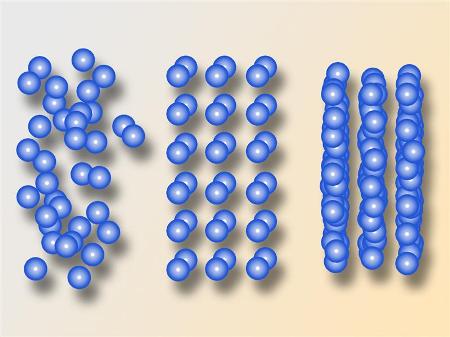The scientists from the University of Vienna and Vienna University of Technology have identified complicated structures created by minute particles suspended in liquids.
 Colloids - unordered, in a crystalline structure and as strings under mechanical strain
Colloids - unordered, in a crystalline structure and as strings under mechanical strain
Particles suspended in liquids such as gruel, ink and blood create clusters, which resemble the regular structures of atoms in a crystal. The researchers were able to investigate the characteristics of these crystal-like materials in computer simulations. When a mechanical strain is applied, the crystalline pattern is deformed into a different pattern or completely disappears, which in turn modifies the properties of the liquid drastically.
Particle clusters instantly create a regular pattern called cluster crystal in which the distance between the adjacent clusters is uniform. When a mechanical strain is applied, the links between the clusters are ruptured, resulting in the melting of crystal-like structures. The molten particle clusters then spontaneously forms another regular pattern of straight, long strings that are organized in parallel. The resultant pattern makes the liquid thinner by decreasing its viscosity.
When more strain is applied, more amounts of particles are disintegrated from their initial positions and block the flow, resulting in rise of liquid viscosity. All types of cluster crystals demonstrate this characteristic. Using a basic theoretical model, the optimum strain at which the crystal structure disappears fully can be estimated precisely. This study in the ‘soft matter’field at the micro- and nanoscale level is critical in applications using customized nanomaterials, including pharmacology, petrochemistry and biotechnology.